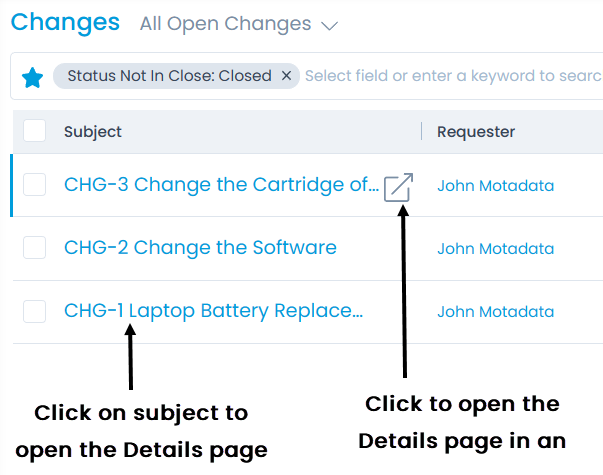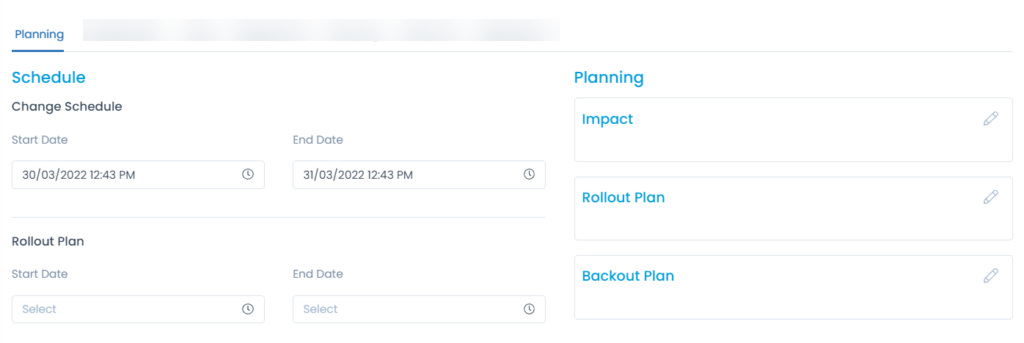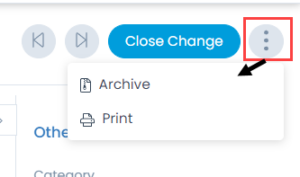Change Details Page
To view the Change Details page, click on the subject of the change or View Details page icon as shown below:

The Change Details page appears.

Subject and Description
You can see the complete subject and the description on the top of the details page.

Classifiers of Change
These properties tell you the current statistics of the change and help you to classify them under different labels. When someone works on a change, they update the labels accordingly. For example: If the status is closed, it means you do not need to do anything on the change.

| Properties | Description |
|---|---|
| Status | This label shows the current status of the change. The status is based on the change workflow. |
| Priority | The label classifies the change based on the priority. The value in this label shows the current priority of the change. The default values are: Low, Medium, High, and Urgent. |
| Urgency | The label classifies the change based on the urgency. The value in this label shows the current urgency of the change. The default values are: Low, Medium, High, and Urgent. |
| Impact | The label classifies the change based on the impact factor. The value in this label shows the current impact of the change. The default values are: Low, On Users, On Department, and On Business. |
| Technician Group | The label helps you sorting the technician when there is a long list. Based on the value selected here, the values of Assignee dropdown changes. |
| Assignee | The label classifies the change based on the person to whom this change is assigned. When the value is unassigned, it means that change is not assigned to anyone. The values of assignee depends on the Technician Group value. You can also know the load of the user based on the color of the load indicator. |
| Due by | Shows the time frame by which you should do all the work related to the change request. This is configurable. You can restrict it by disabling the "Update Due By" permission either from the SLA Setting or from User Role permission. Notes: - If SLA is applied, to edit both the permissions should be enabled. If either of them is disabled, the edit icon will not be available. - If SLA is not applied, the edit icon will be available based on the Update Due By role permission. |
| Change Risk | Shows the risk related to the change. The options are: Low, Medium, and High. |
| Change Type | Shows the type of the change. The default values are: Minor, Standard, Significant, Major, and Emergency. |
| Add Tags | You can add the custom tags to quickly find the changes based on it. Also, system adds some default tags when based on certain labels and actions. |
Associated Actions for Change
You can create or update different actions and activities as a part of communication, collaboration, and resolution in the change. The available types of actions are:
| Action Types | Description |
|---|---|
| Planning | You can create a schedule and the plan related to the change. |
| Collaboration | You can add collaboration messages and notes related to the change. |
| Tasks | You can add and manage different tasks related to the change. |
| Similar Tickets | You can view similar requests, problems, and change requests. |
| Approvals | You can see the approvals given for the change and remind the concerned technician about it. |
| Relations | You can relate the change request with other change, request, problem, release, asset, knowledge, and project. |
| SLA | You can view the SLAs and UCs running on a change request along with its details like Name, type, Target, Status, etc. |
| Work Log | You can add and manage the work log about the time and actions spent on the change. |
| Audit Trail | You can see the activity in the journal of all the actions related to the change. |
| Notifications | You can send notifications related to the change. |

Other Information
The other information displays additional details about the change. You can change them if required.

- Category: Shows the category of the change. Default values are: Software, Hardware, Network, HR, or Other.
- Department: Shows the name of the department to which the change request belongs.
- Company: Shows the company associated with the change. This field is available only if the Managed Services Provider feature is enabled.
- Location: Shows the location from where the change is generated.
- Change Reason: Show the reason for change.
- Change Type: Shows the type of change.
- Target Environment: Shows the environment on which change will affect. Default values are: Production, Development, and Test.
- Implementer: Shows the name of the person who is implementing the change.
- Manager: Shows the name of the manager who is owning the change.
- Reviewer: Shows the name of the reviewer who is reviewing the change.
- Current SLA: Shows the assigned SLA.
- Transition Model: Shows the transition model applied to the change.
- Escalation Level: Shows the escalation level of the change.
- Template: Shows the name of the template used to create the change.
- Change Age: Shows the age of the ticket in terms of duration between the creation and the current Date and Time.
- Last Update Date: Shows the date and timestamp of the last activity on the change.
Change Actions
On the top-right corner of the page, you will see a set of actions.

- Previous: Click to go to the previous change.
- Next: Click to go to the next change.
- Close: Click the Close Change button to close the change. Click here to see what happens when you close a change.
- More Actions: Click on the vertical 3 dots to see other actions available for the change. The options are:
- Archive: Select to archive the change.
- Print: Select to print the change details in PDF format.